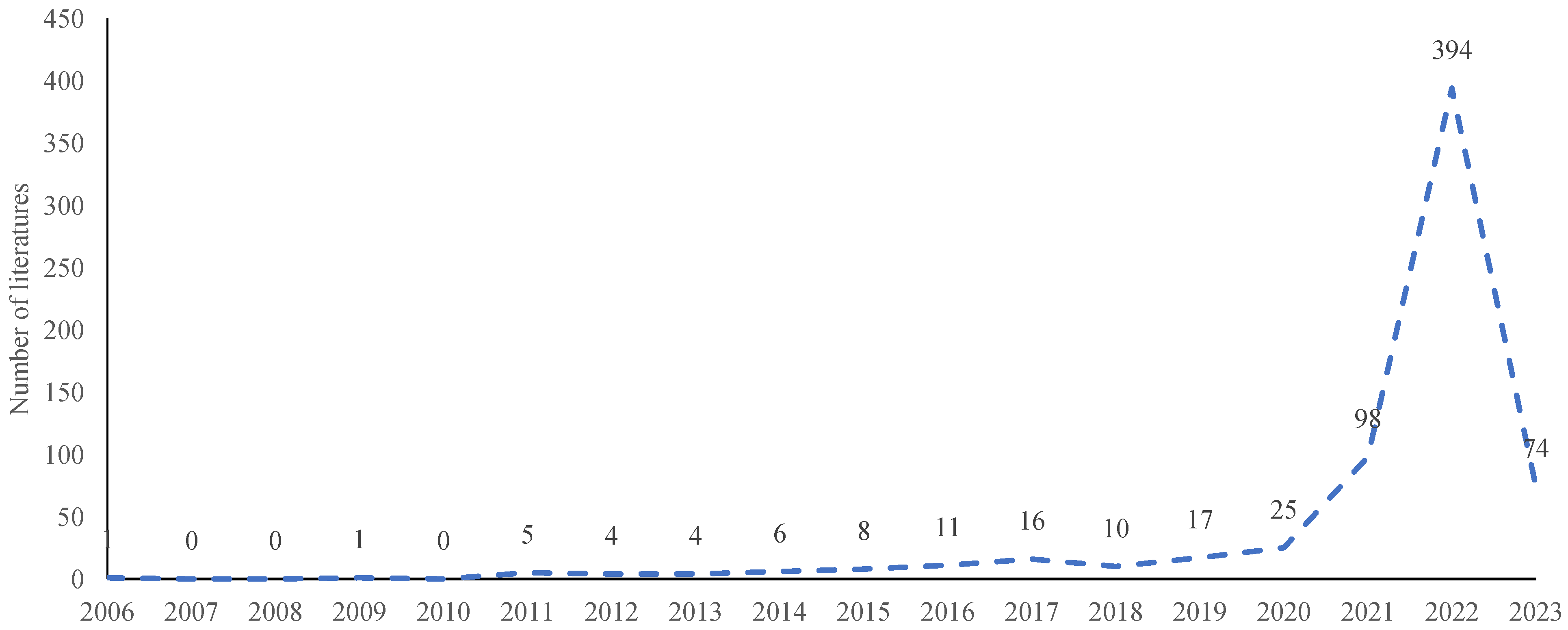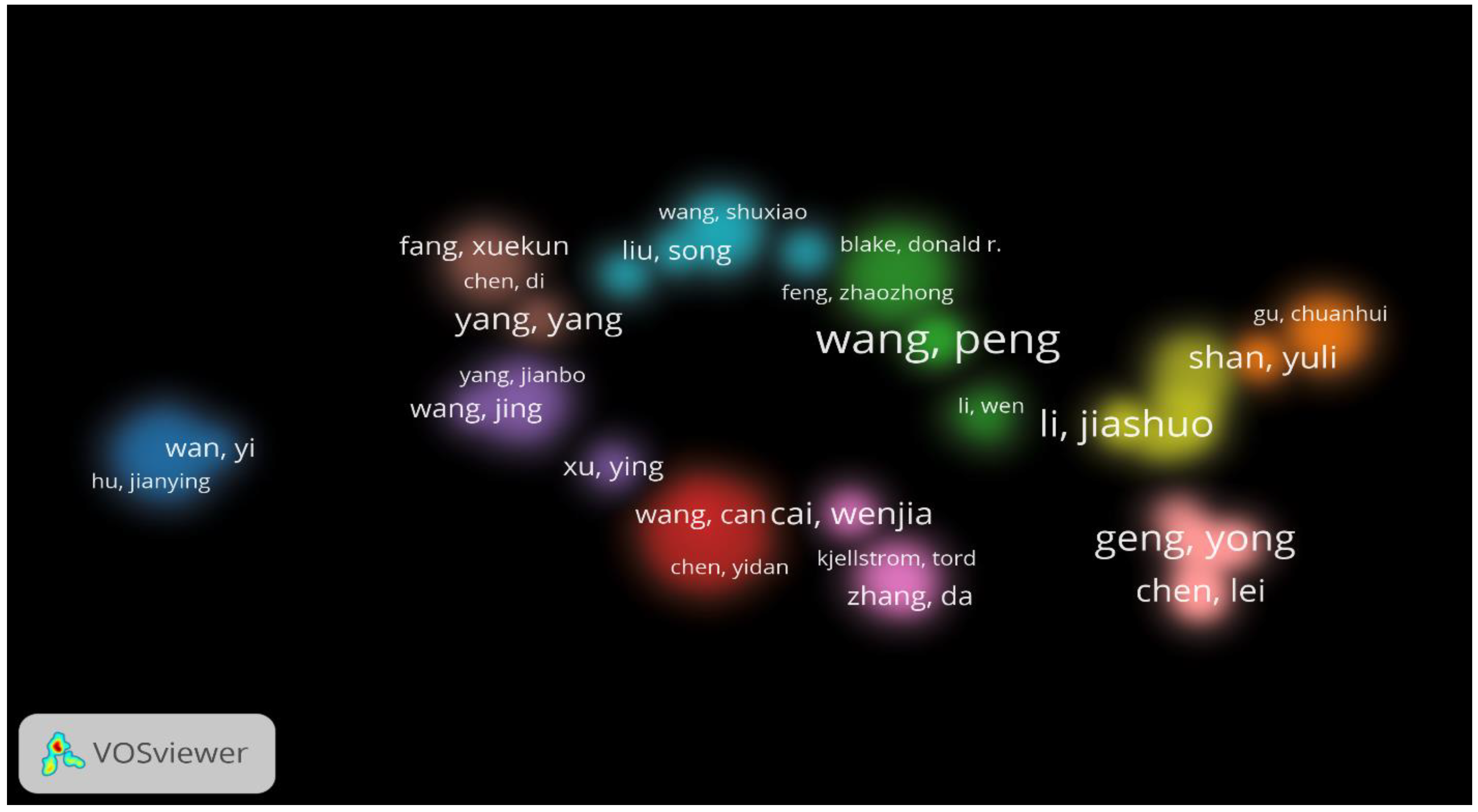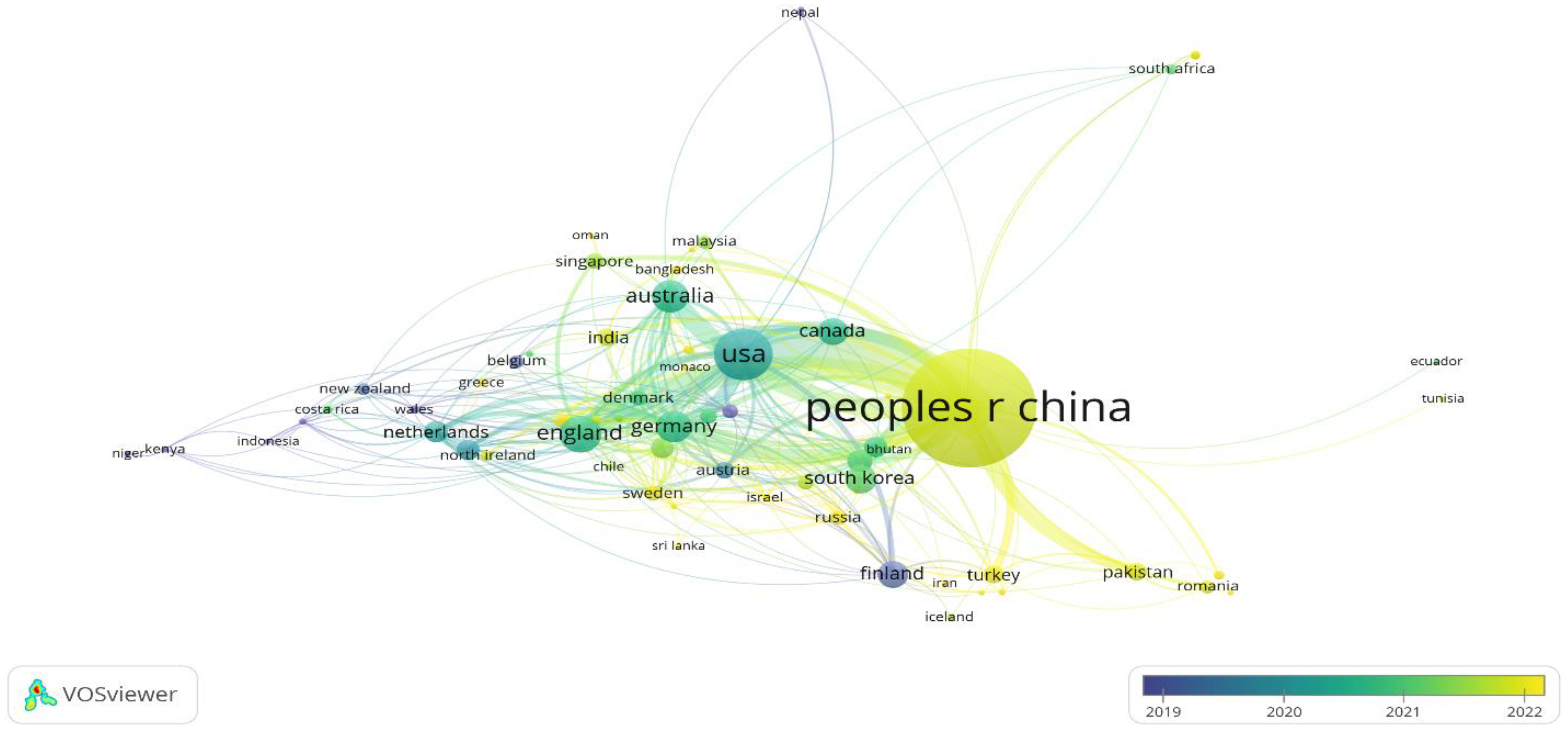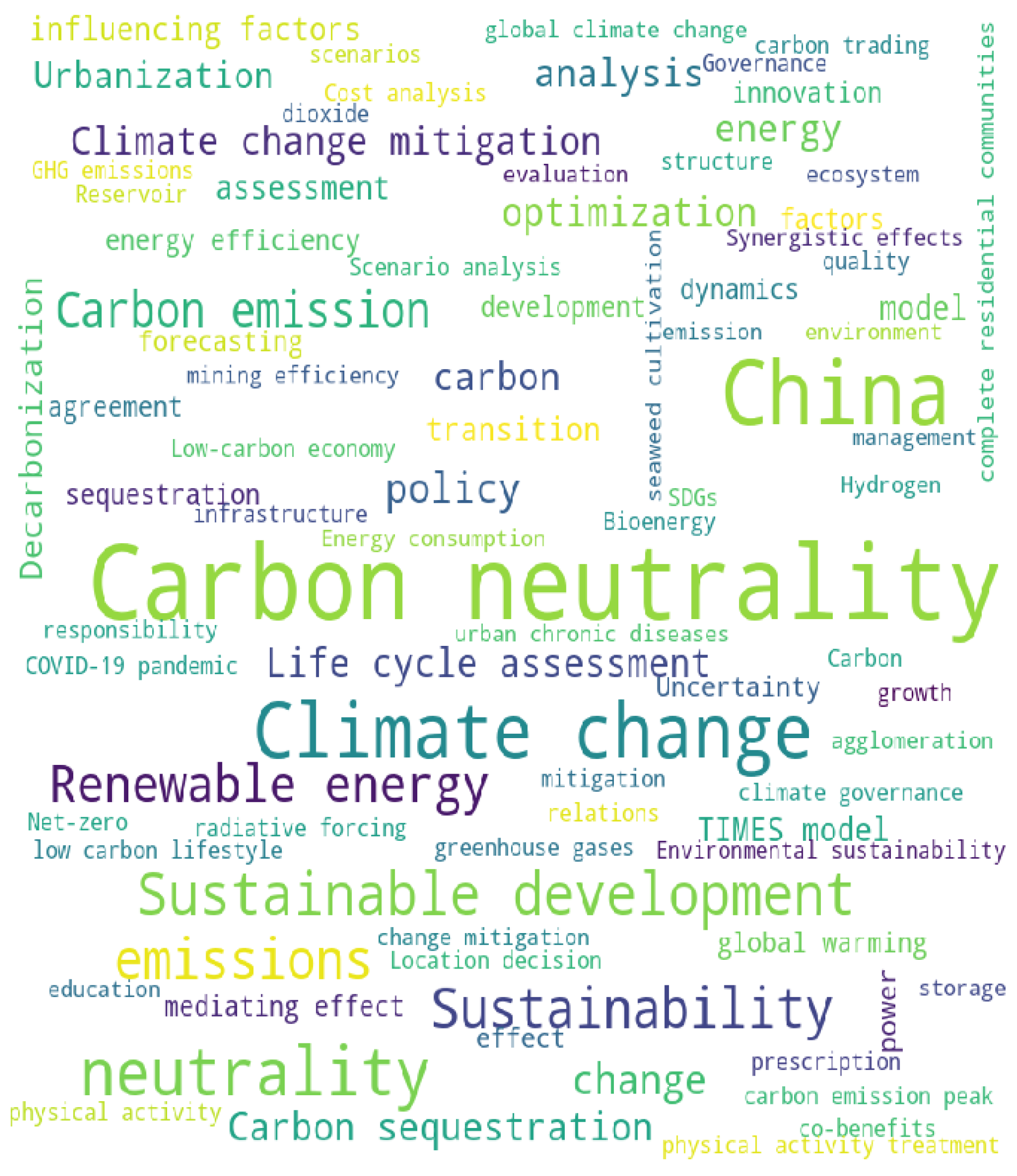Climate Change, Carbon Peaks, and Carbon Neutralization: A Bibliometric Study from 2006 to 2023
Abstract
1. Introduction
1.1. Adaptation to Global Climate Change
1.2. Overview of Carbon Neutrality in China
1.3. Objectives and Contributions
2. Materials and Aims of the Study
3. Bibliometric Analysis
3.1. Analysis of the Number of Literature Articles
3.2. Analysis of Authors and Countries
3.3. Analysis of Research Institutions
4. Overview of Climate Change, Carbon Peaks, and Carbon Neutralization Research
4.1. Carbon Peak
4.2. Carbon Neutralization
5. Discussion and Conclusions
Author Contributions
Funding
Institutional Review Board Statement
Informed Consent Statement
Data Availability Statement
Conflicts of Interest
References
- Lau, Y.Y.; Yip, T.L.; Dulebenets, M.A.; Tang, Y.M.; Kawasaki, T. A review of historical changes of tropical and extra-tropical cyclones: A comparative analysis of the United States, Europe, and Asia. Int. J. Environ. Res. Public Health 2022, 19, 4499. [Google Scholar] [CrossRef] [PubMed]
- Ng, A.K.Y.; Zhang, H.; Afenyo, M.; Becker, A.; Cahoon, S.; Chen, S.-L.; Esteban, M.; Ferrari, C.; Lau, Y.-Y.; Lee, P.T.-W.; et al. Port Decision Maker Perceptions on the Effectiveness of Climate Adaptation Actions. Coast. Manag. 2018, 46, 148–175. [Google Scholar] [CrossRef]
- Li, T.; Ma, L.; Liu, Z.; Yi, C.; Liang, K. Dual carbon goal-based quadrilateral evolutionary game: Study on the new energy vehicle industry in China. Int. J. Environ. Res. Public Health 2023, 20, 3217. [Google Scholar] [CrossRef] [PubMed]
- Zhang, Y.; Fei, X.; Liu, F.; Chen, J.; You, X.; Huang, S.; Wang, M.; Dong, J. Advances in Forest Management Research in the Context of Carbon Neutrality: A Bibliometric Analysis. Forests 2022, 13, 1810. [Google Scholar] [CrossRef]
- Zhao, X.; Shang, Y.; Song, M. Industrial structure distortion and urban ecological efficiency from the perspective of green entrepreneurial ecosystems. Socio-Econ. Plan. Sci. 2020, 72, 100757. [Google Scholar] [CrossRef]
- Zhang, X.; Shi, X.; Khan, Y.; Hassan, T.; Marie, M. Carbon Neutrality Challenge: Analyse the Role of Energy Productivity, Renewable Energy, and Collaboration in Climate Mitigation Technology in OECD Economies. Sustainability 2023, 15, 3447. [Google Scholar] [CrossRef]
- Liu, Z.; Li, P.; Wang, F.; Osmani, M.; Demian, P. Building Information Modeling (BIM) Driven Carbon Emission Reduction Research: A 14-Year Bibliometric Analysis. Int. J. Environ. Res. Public Health 2022, 19, 12820. [Google Scholar] [CrossRef]
- Salvia, M.; Reckien, D.; Pietrapertosa, F.; Eckersley, P.; Spyridaki, N.-A.; Krook-Riekkola, A.; Olazabal, M.; De Gregorio Hurtado, S.; Simoes, S.G.; Geneletti, D.; et al. Will climate mitigation ambitions lead to carbon neutrality? An analysis of the local-level plans of 327 cities in the EU. Renew. Sustain. Energy Rev. 2021, 135, 110253. [Google Scholar] [CrossRef]
- Ouyang, Z.; Sciusco, P.; Jiao, T.; Feron, S.; Lei, C.; Li, F.; John, R.; Fan, P.; Li, X.; Williams, C.A.; et al. Albedo changes caused by future urbanization contribute to global warming. Nat. Commun. 2022, 13, 3800. [Google Scholar] [CrossRef]
- Birkmann, J.; Garschagen, M.; Kraas, F.; Quang, N. Adaptive urban governance: New challenges for the second generation of urban adaptation strategies to climate change. Sustain. Sci. 2010, 5, 185–206. [Google Scholar] [CrossRef]
- Chu, Z.; Cheng, M.; Yu, N.N. A smart city is a less polluted city. Technol. Forecast. Soc. Chang. 2021, 172, 121037. [Google Scholar] [CrossRef]
- Zhao, R.; Wu, D.; Patti, S. A Bibliometric Analysis of Carbon Labeling Schemes in the Period 2007–2019. Energies 2020, 13, 4233. [Google Scholar] [CrossRef]
- Dewan, M.H.; Godina, R. Effective Training of Seafarers on Energy Efficient Operations of Ships in the Maritime Industry. Procedia Comput. Sci. 2023, 217, 1688–1698. [Google Scholar] [CrossRef]
- Yang, W.; Min, Z.; Yang, M.; Yan, J. Exploration of the Implementation of Carbon Neutralization in the Field of Natural Resources under the Background of Sustainable Development-An Overview. Int. J. Environ. Res. Public Health 2022, 19, 14109. [Google Scholar] [CrossRef] [PubMed]
- Jin, B. Research on performance evaluation of green supply chain of automobile enterprises under the background of carbon peak and carbon neutralization. Energy Rep. 2021, 7, 594–604. [Google Scholar] [CrossRef]
- Min, Z.; Jing, J.Z. Bibliometric Analysis of Tourism Education Research in China. J. Anhui Univ. Technol. (Soc. Sci.) 2020, 37, 5. [Google Scholar]
- Zhao, X.; Ma, X.; Chen, B.; Shang, Y.; Song, M. Challenges toward carbon neutrality in China: Strategies and countermeasures. Resour. Conserv. Recycl. 2022, 176, 105959. [Google Scholar] [CrossRef]
- Wu, J.; Mohamed, R.; Wang, Z. An Agent-Based Model to Project China’s Energy Consumption and Carbon Emission Peaks at Multiple Levels. Sustainability 2017, 9, 893. [Google Scholar] [CrossRef]
- Li, S.; Zhou, C.; Wang, S. Does modernization affect carbon dioxide emissions? A panel data analysis. Sci. Total Environ. 2019, 663, 426–435. [Google Scholar] [CrossRef]
- Qi, Y.; Stern, N.; He, J.-K.; Lu, J.-Q.; Liu, T.-L.; King, D.; Wu, T. The policy-driven peak and reduction of China’s carbon emissions. Adv. Clim. Chang. Res. 2020, 11, 65–71. [Google Scholar] [CrossRef]
- Chen, J.; Cui, H.; Xu, Y.; Ge, Q. Long-term temperature and sea-level rise stabilization before and beyond 2100: Estimating the additional climate mitigation contribution from China’s recent 2060 carbon neutrality pledge. Environ. Res. Lett. 2021, 16, 074032. [Google Scholar] [CrossRef]
- Meng, M.; Jing, K.; Mander, S. Scenario analysis of CO2 emissions from China’s electric power industry. J. Clean. Prod. 2017, 142, 3101–3108. [Google Scholar] [CrossRef]
- Tao, Y.; Wen, Z.; Xu, L.; Zhang, X.; Tan, Q.; Li, H.; Evans, S. Technology options: Can Chinese power industry reach the CO2 emission peak before 2030? Resour. Conserv. Recycl. 2019, 147, 85–94. [Google Scholar] [CrossRef]
- Li, W.; Jia, Z. The impact of emission trading scheme and the ratio of free quota: A dynamic recursive CGE model in China. Appl. Energy 2016, 174, 1–14. [Google Scholar] [CrossRef]
- Duan, H.; Mo, J.; Fan, Y.; Wang, S. Achieving China’s energy and climate policy targets in 2030 under multiple uncertainties. Energy Econ. 2018, 70, 45–60. [Google Scholar] [CrossRef]
- Matsumoto, K.I.; Tachiiri, K.; Kawamiya, M. Evaluating multiple emission pathways for fixed cumulative carbon dioxide emissions from global-scale socioeconomic perspectives. Mitig. Adapt. Strateg. Glob. Chang. 2018, 23, 1–26. [Google Scholar] [CrossRef] [PubMed]
- Yu, S.; Zheng, S.; Li, X.; Li, L. China can peak its energy-related carbon emissions before 2025: Evidence from industry restructuring. Energy Econ. 2018, 73, 91–107. [Google Scholar] [CrossRef]
- Ding, S.; Zhang, M.; Song, Y. Exploring China’s carbon emissions peak for different carbon tax scenarios. Energy Policy 2019, 129, 1245–1252. [Google Scholar] [CrossRef]
- Meng, M.; Shang, W.; Wang, X.; Pang, T. When will China fulfill its carbon-related intended nationally determined contributions? An in-depth environmental Kuznets curve analysis. Greenh. Gases Sci. Technol. 2020, 10, 1039–1049. [Google Scholar] [CrossRef]
- Su, Y.; Liu, X.; Ji, J.; Ma, X. Role of economic structural change in the peaking of China’s CO2 emissions: An input–output optimization model. Sci. Total Environ. 2021, 761, 143306. [Google Scholar] [CrossRef]
- Pan, X.; Teng, F. Assessment of China’s Mitigation Targets in an Effort-Sharing Framework. Sustainability 2017, 9, 1104. [Google Scholar] [CrossRef]
- Strefler, J.; Bauer, N.; Humpenöder, F.; Klein, D.; Popp, A.; Kriegler, E. Carbon dioxide removal technologies are not born equal. Environ. Res. Lett. 2021, 16, 074021. [Google Scholar] [CrossRef]
- Strefler, J.; Kriegler, E.; Bauer, N.; Luderer, G.; Pietzcker, R.C.; Giannousakis, A.; Edenhofer, O. Alternative carbon price trajectories can avoid excessive carbon removal. Nat. Commun. 2021, 12, 2264. [Google Scholar] [CrossRef]
- Hu, K.; Raghutla, C.; Chittedi, K.R.; Zhang, R.; Koondhar, M.A. The effect of energy resources on economic growth and carbon emissions: A way forward to carbon neutrality in an emerging economy. J. Environ. Manag. 2021, 298, 113448. [Google Scholar] [CrossRef]
- Liu, B.; Liu, S.; Xue, B.; Lu, S.; Yang, Y. Formalizing an integrated decision-making model for the risk assessment of carbon capture, utilization, and storage projects: From a sustainability perspective. Appl. Energy 2021, 303, 117624. [Google Scholar] [CrossRef]
- Iqbal, N.; Abbasi, K.R.; Shinwari, R.; Guangcai, W.; Ahmad, M.; Tang, K. Does exports diversification and environmental innovation achieve carbon neutrality target of OECD economies? J. Environ. Manag. 2021, 291, 112648. [Google Scholar] [CrossRef]
- Liu, X.; Liu, X. Can Financial Development Curb Carbon Emissions? Empirical Test Based on Spatial Perspective. Sustainability 2021, 13, 11912. [Google Scholar] [CrossRef]
- Tudor, C.; Sova, R. On the Impact of GDP per Capita, Carbon Intensity and Innovation for Renewable Energy Consumption: Worldwide Evidence. Energies 2021, 14, 6254. [Google Scholar] [CrossRef]
- Zhou, D.; Hu, F.; Zhu, Q.; Wang, Q. Regional allocation of renewable energy quota in China under the policy of renewable portfolio standards. Resour. Conserv. Recycl. 2022, 176, 105904. [Google Scholar] [CrossRef]
- Huang, M.-T.; Zhai, P.-M. Achieving Paris Agreement temperature goals requires carbon neutrality by middle century with far-reaching transitions in the whole society. Adv. Clim. Chang. Res. 2021, 12, 281–286. [Google Scholar] [CrossRef]
- Wang, G.; Shi, R.; Cheng, W.; Gao, L.; Huang, X. Bibliometric analysis for carbon neutrality with hotspots, frontiers, and emerging trends between 1991 and 2022. Int. J. Environ. Res. Public Health 2023, 20, 926. [Google Scholar] [CrossRef] [PubMed]
- Zhang, Z.; Hu, G.; Mu, X.; Li, K. From low carbon to carbon neutrality: A bibliometric analysis of the status, evolution and development trend. J. Environ. Manag. 2022, 322, 116087. [Google Scholar] [CrossRef] [PubMed]




| Institution Name | Number of Journals |
|---|---|
| Chinese Acad. Sci. | 92 |
| Tsinghua Univ. | 60 |
| Univ. Chinese Acad. Sci. | 38 |
| Shanghai Jiao Tong Univ. | 32 |
| Peking Univ. | 26 |
| Wuhan Univ. | 23 |
| Xiamen Univ. | 19 |
| China Univ. Geosci. | 19 |
| Beijing Forestry Univ. | 16 |
| Nanjing Univ. | 14 |
Disclaimer/Publisher’s Note: The statements, opinions and data contained in all publications are solely those of the individual author(s) and contributor(s) and not of MDPI and/or the editor(s). MDPI and/or the editor(s) disclaim responsibility for any injury to people or property resulting from any ideas, methods, instructions or products referred to in the content. |
© 2023 by the authors. Licensee MDPI, Basel, Switzerland. This article is an open access article distributed under the terms and conditions of the Creative Commons Attribution (CC BY) license (https://creativecommons.org/licenses/by/4.0/).
Share and Cite
Chen, Q.; Zhang, H.; Lau, Y.-Y.; Wang, T.; Wang, W.; Zhang, G. Climate Change, Carbon Peaks, and Carbon Neutralization: A Bibliometric Study from 2006 to 2023. Sustainability 2023, 15, 5723. https://doi.org/10.3390/su15075723
Chen Q, Zhang H, Lau Y-Y, Wang T, Wang W, Zhang G. Climate Change, Carbon Peaks, and Carbon Neutralization: A Bibliometric Study from 2006 to 2023. Sustainability. 2023; 15(7):5723. https://doi.org/10.3390/su15075723
Chicago/Turabian StyleChen, Qiong, Hongyu Zhang, Yui-Yip Lau, Tianni Wang, Wen Wang, and Guangsheng Zhang. 2023. "Climate Change, Carbon Peaks, and Carbon Neutralization: A Bibliometric Study from 2006 to 2023" Sustainability 15, no. 7: 5723. https://doi.org/10.3390/su15075723
APA StyleChen, Q., Zhang, H., Lau, Y.-Y., Wang, T., Wang, W., & Zhang, G. (2023). Climate Change, Carbon Peaks, and Carbon Neutralization: A Bibliometric Study from 2006 to 2023. Sustainability, 15(7), 5723. https://doi.org/10.3390/su15075723







